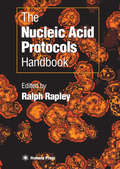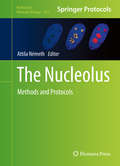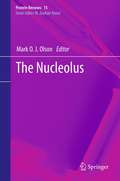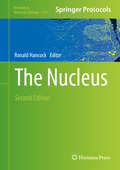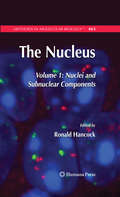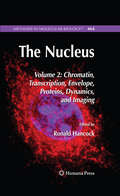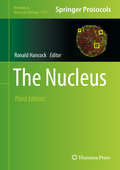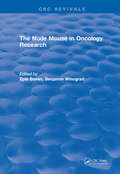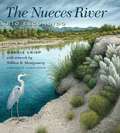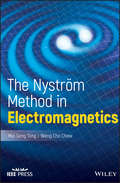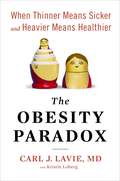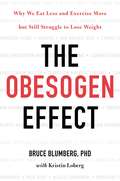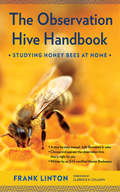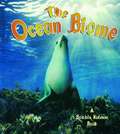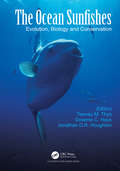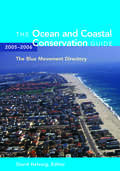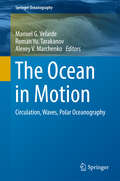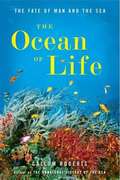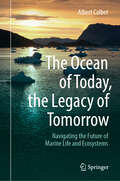- Table View
- List View
The Nuclear Spies: America's Atomic Intelligence Operation against Hitler and Stalin
by Vince HoughtonWhy did the US intelligence services fail so spectacularly to know about the Soviet Union's nuclear capabilities following World War II? As Vince Houghton, historian and curator of the International Spy Museum in Washington, DC, shows us, that disastrous failure came just a few years after the Manhattan Project's intelligence team had penetrated the Third Reich and knew every detail of the Nazi 's plan for an atomic bomb. What changed and what went wrong?Houghton's delightful retelling of this fascinating case of American spy ineffectiveness in the then new field of scientific intelligence provides us with a new look at the early years of the Cold War. During that time, scientific intelligence quickly grew to become a significant portion of the CIA budget as it struggled to contend with the incredible advance in weapons and other scientific discoveries immediately after World War II. As Houghton shows, the abilities of the Soviet Union's scientists, its research facilities and laboratories, and its educational system became a key consideration for the CIA in assessing the threat level of its most potent foe. Sadly, for the CIA scientific intelligence was extremely difficult to do well. For when the Soviet Union detonated its first atomic bomb in 1949, no one in the American intelligence services saw it coming.
The Nucleic Acid Protocols Handbook
by Ralph RapleyA comprehensive treasury of all the key molecular biology methods-ranging from DNA extraction to gene localization in situ-needed to function effectively in the modern laboratory. Each of the 120 highly successful techniques follows the format of the much acclaimed Methods in Molecular BiologyTM series, providing an introduction to the scientific basis of each technique, a complete listing of all the necessary materials and reagents, and clear step-by-step instruction to permit error-free execution. Included for each technique are notes about pitfalls to avoid, troubleshooting tips, alternate methods, and explanations of the reasons for certain steps-all key elements contributing significantly to success or failure in the lab. The Nucleic Acid Protocols Handbook constitutes today's most comprehensive collection of all the key classic and cutting-edge techniques for the successful isolation, analysis, and manipulation of nucleic acids by both experienced researchers and those new to the field.
The Nucleolus
by Attila NémethThis volume provides an up-to-date compilation of current methodological approaches utilized for the exploration of nucleolar structure and function. Chapters cover a diversity of protocols that include imaging of the nucleolus, analysis of ribosomal RNA transcription and processing, and genomics and proteomics of the nucleolus. Written in the highly successful Methods in Molecular Biology series format, chapters include introductions to their respective topics, lists of the necessary materials and reagents, step-by-step, readily reproducible laboratory protocols, and tips on troubleshooting and avoiding known pitfalls. Authoritative and practical, The Nucleolus: Methods and Protocols provides scientists with a reliable practical handbook to facilitate the investigation of this nuclear compartment at the advanced level.
The Nucleolus
by Mark O. OlsonWithin the past two decades, extraordinary new functions for the nucleolus have begun to appear, giving the field a new vitality and generating renewed excitement and interest. These new discoveries include both newly-discovered functions and aspects of its conventional role. The Nucleolus is divided into three parts: nucleolar structure and organization, the role of the nucleolus in ribosome biogenesis, and novel functions of the nucleolus.
The Nucleus, 2nd Edition
by Ronald HancockThis volume presents detailed, recently-developed protocols ranging from isolation of nuclei to purification of chromatin regions containing single genes, with a particular focus on some less well-explored aspects of the nucleus. The methods described include new strategies for isolation of nuclei, for purification of cell type-specific nuclei from a mixture, and for rapid isolation and fractionation of nucleoli. For gene delivery into and expression in nuclei, a novel gentle approach using gold nanowires is presented. As the concentration and localization of water and ions are crucial for macromolecular interactions in the nucleus, a new approach to measure these parameters by correlative optical and cryo-electron microscopy is described. The Nucleus, Second Edition presents methods and software for high-throughput quantitative analysis of 3D fluorescence microscopy images, for quantification of the formation of amyloid fibrils in the nucleus, and for quantitative analysis of chromosome territory localization. Written in the successful Methods in Molecular Biology series format, chapters include introductions to their respective topics, lists of the necessary materials and reagents, step-by-step, readily reproducible protocols, and notes on troubleshooting and avoiding known pitfalls.<P><P> Authoritative and easily accessible, The Nucleus, Second Edition seeks to serve both professionals and novices with its well-honed methods for the study of the nucleus.
The Nucleus, Volume 1: Nuclei and Subnuclear Components
by Ronald HancockAlthough our understanding of the structure and activities of the cell nucleus and of the nanomachines which it contains is increasing rapidly, much remains to be learned. The application and continuing development of the new, powerful biochemical and biophysical methodologies described here are essential in this quest. In The Nucleus, researchers from more than forty leading international laboratories describe state-of-the-art methods for isolating nuclei and their components and for studying their structure and activities, including some pathology-associated features. Volume I: Nuclei and Subnuclear Structures presents an overview of features of the intranuclear environment, followed by the most recent procedures for isolating nuclei from a wide range of cell types including muscle cells, yeast, oocytes, cells with polytene nuclei, Arabidopsis, trypanosomes, and dinoflagellates. The latest methods are described for isolating and working with nucleoli, constitutive heterochromatin, pathology-associated inclusions, and chromatin and for examining glycosylation, sumoylation, and ADP-ribosylation of nuclear proteins. Written in the highly successful Methods in Molecular Biology™ series format, chapters contain lists of necessary materials and reagents, readily reproducible protocols, and tips for troubleshooting and avoiding known pitfalls.<P><P> The Nucleus, Volume I: Nuclei and Subnuclear Structures is an essential reference for scientists who are working on our rapidly growing understanding of the cell nucleus and its activities.
The Nucleus, Volume 2: Chromatin, Transcription, Envelope, Proteins, Dynamics, and Imaging
by Ronald HancockAlthough our understanding of the structure and activities of the cell nucleus and of the nanomachines which it contains is increasing rapidly, much remains to be learned. The application and continuing development of the new, powerful biochemical and biophysical methodologies described here are essential in this quest. In The Nucleus, researchers from more than forty leading international laboratories describe state-of-the-art methods for isolating nuclei and their components and for studying their structure and activities, including some pathology-associated features. Volume 2: Chromatin, Transcription, Envelope, Proteins, Dynamics, and Imaging presents biophysical approaches to study the mechanical properties of nuclei, together with a comprehensive range of imaging methods. These include FISH, FRAP, FRET, molecular beacons, fluorescence correlation spectroscopy, single molecule tracking, and combing DNA for optical microscopy, recognition imaging for atomic force microscopy, and hybridisation, tomography, and spectroscopic imaging for electron microscopy. Written in the highly successful Methods in Molecular Biology™ series format, chapters contain lists of necessary materials and reagents, readily reproducible protocols, and tips for troubleshooting and avoiding known pitfalls.<P><P> The Nucleus, Volume 2: Chromatin, Transcription, Envelope, Proteins, Dynamics, and Imaging provides a comprehensive collection of the cutting-edge methods making a major contribution to understanding the nucleus and its nanostructure today.
The Nucleus: Volume 1: Nuclei And Subnuclear Components (Methods in Molecular Biology #2175)
by Ronald HancockThis detailed new edition delves into recently developed protocols for those working on cell nucleus research, including some of the less well-explored areas of study. Like the previous editions, this book features contributions from top experts in their respective fields. Written for the highly successful Methods in Molecular Biology series, chapters include introductions to their topics, lists of the necessary materials and reagents, step-by-step, readily reproducible laboratory protocols, and tips on troubleshooting and avoiding known pitfalls. Authoritative and up-to-date, The Nucleus, Third Edition will help students and postdocs become aware of vital available methodologies when planning their new projects.
The Nude Mouse in Oncology Research
by Epie BovenThe nude, athymic mouse (nu/nu) has become generally accepted as a valuable tool to study the biology and therapy of human cancers. This volume presents a critical review of the scientific merits of the animal as a recipient of human tumor tissue transplants. Important information is provided regarding biology, immunology, and measures for genetic and microbiological control of the nude mouse. The discussion of transplantation sites and transplantability of human tumor tissue to the animals includes both the description of host factors and the tumor type involved. The characterization and monitoring of xenografts is followed by a review on their possible application for studies in tumor biology, such as hormones, growth factors, drug resistance, tumor markers, and heterogeneity. Experimental therapy is dedicated to cytostatic agents, hormones, monoclonal antibodies, cytokines, differentiation inducers and radiotherapy. The book also provides critical remarks regarding the limitation of the nude-mouse tumor models. The Nude Mouse in Oncology Research will provide essential reference information for oncology researchers, researchers who work with the nude mouse on a regular basis, and pharmaceutical companies.
The Nueces River: Río Escondido (River Books)
by Margie CrispFirst appearing on early Spanish maps as the Río Escondido, or hidden river, and later named Río de las Nueces after the abundant pecan trees along its banks, the Nueces today is a stream of seeming contradictions: a river that runs above and below ground; a geographic reminder of a history both noble and egregious; and a spring-fed stream transformed into a salty, steep-sided channel. <P><P>From its fresh, clear headwaters on the Edwards Plateau, Margie Crisp and William B. Montgomery follow the river through the mesquite and prickly pear of the South Texas Plains, to the river’s end in Nueces and Corpus Christi Bays on the Gulf of Mexico. With vivid prose and paintings, they record their travels as they explore the length of the river on foot, kayak, and fishing boat, ultimately weaving a vivid portrait of today’s Nueces. Capturing the river’s subtle beauty, abundant wildlife, diverse culture, and unique history of exploration, conflict, and settlement, they reveal the untold story of this enigmatic river with passion, humor, and reverence.
The Number of the Heavens: A History of the Multiverse and the Quest to Understand the Cosmos
by Tom SiegfriedOne of the most controversial, cutting-edge ideas in cosmology—the possibility that there exist multiple parallel universes—in fact has a long history. Tom Siegfried reminds us that the size and number of the heavens have been contested since ancient times. His story offers deep lessons about the nature of science and the quest for understanding.
The Numerical Method of Lines and Duality Principles Applied to Models in Physics and Engineering
by Fabio Silva BotelhoThe book includes theoretical and applied results of a generalization of the numerical method of lines. A Ginzburg-Landau type equation comprises the initial application, with detailed explanations about the establishment of the general line expressions. Approximate numerical procedures have been developed for a variety of equation types, including the related algorithms and software. The applications include the Ginzburg-Landau system in superconductivity, applications to the Navier-Stokes system in fluid mechanics and, among others, models in flight mechanics. In its second and final parts, the book develops duality principles and numerical results for other similar and related models. The book is meant for applied mathematicians, physicists and engineers interested in numerical methods and concerning duality theory. It is expected the text will serve as a valuable auxiliary project tool for some important engineering and physics fields of research.
The Nystrom Method in Electromagnetics (Wiley - IEEE)
by Mei Song Tong Weng Cho ChewA comprehensive, step-by-step reference to the Nyström Method for solving Electromagnetic problems using integral equations Computational electromagnetics studies the numerical methods or techniques that solve electromagnetic problems by computer programming. Currently, there are mainly three numerical methods for electromagnetic problems: the finite-difference time-domain (FDTD), finite element method (FEM), and integral equation methods (IEMs). In the IEMs, the method of moments (MoM) is the most widely used method, but much attention is being paid to the Nyström method as another IEM, because it possesses some unique merits which the MoM lacks. This book focuses on that method—providing information on everything that students and professionals working in the field need to know. Written by the top researchers in electromagnetics, this complete reference book is a consolidation of advances made in the use of the Nyström method for solving electromagnetic integral equations. It begins by introducing the fundamentals of the electromagnetic theory and computational electromagnetics, before proceeding to illustrate the advantages unique to the Nyström method through rigorous worked out examples and equations. Key topics include quadrature rules, singularity treatment techniques, applications to conducting and penetrable media, multiphysics electromagnetic problems, time-domain integral equations, inverse scattering problems and incorporation with multilevel fast multiple algorithm. Systematically introduces the fundamental principles, equations, and advantages of the Nyström method for solving electromagnetic problems Features the unique benefits of using the Nyström method through numerical comparisons with other numerical and analytical methods Covers a broad range of application examples that will point the way for future research The Nystrom Method in Electromagnetics is ideal for graduate students, senior undergraduates, and researchers studying engineering electromagnetics, computational methods, and applied mathematics. Practicing engineers and other industry professionals working in engineering electromagnetics and engineering mathematics will also find it to be incredibly helpful.
The Obesity Paradox
by Carl J. LavieMost of us think that longevity hinges on maintaining a normal Body Mass Index. But research conducted over the last decade hit the media in January with explosive news: Overweight and even moderately obese people with certain chronic diseases#151;from heart disease to cancer#151; often live longer and fare better than normalweight individuals with the same ailments. In this groundbreaking book, Carl Lavie, MD, reveals the science behind the obesity paradox and shows us how to achieve maximum health rather than minimum weight. Lavie not only explains how extra fat provides additional fuel to help fight illness, he also argues that we’ve gotten so used to framing health issues in terms of obesity that we overlook other potential causes of disease. Picking up where the bestseller Fat Chance left off, The Obesity Paradox will change the conversation about fat#151;and what it means to be healthy.
The Obesogen Effect: Why We Eat Less And Exercise More But Still Struggle To Lose Weight
by Kristin Loberg Bruce BlumbergAn eye-opening account of the landmark research into the hidden chemicals that are endangering our health and keeping us fatBeing overweight is not just the result of too many cheeseburgers or not enough exercise. According to leading-edge science, there are silent saboteurs in our daily lives that contribute greatly to our obesity epidemic: obesogens. These weight-inducing offenders, most of which are chemicals, disrupt our hormonal systems, alter how we create and store fat, and change how we respond to dietary choices. Because they are largely unregulated, obesogens lurk all around us-in food, furniture, plastic products such as water bottles and food storage containers, and other surprising exposure points. Even worse: research has shown that the effects of some obesogens can be passed on to future generations by irreversibly interfering with the expression of our genes. The good news is we can protect ourselves by becoming more informed consumers. In THE OBESOGEN EFFECT, Dr. Bruce Blumberg describes how obesogens work, reveals where they are found, and offers a practical three-step solution for reducing exposures. He explains why one size does not fit all in a weight loss program, what hides in our household goods, and how we should shop for items we buy every day-from vegetables and meats to canned soup as well as household cleaners, air fresheners, and personal care products. THE OBESOGEN EFFECT is an urgent call to action to protect your body, clean up your life, and set a straight course for better health.
The Observation Hive Handbook: Studying Honey Bees at Home
by Frank LintonThis book will guide you in selecting an observation hive and choosing a site for it, modifying the hive and the site as needed, installing the hive, working with the hive, and maintaining the hive. It will prepare you to take a temporary portable observation hive to a market, fair, or school. Most important, it describes and illustrates the many ways you can use your observation hive to learn more about honey bees and how to care for them.
The Observer's Guide to Planetary Motion
by Dominic FordTo the naked eye, the most evident defining feature of the planets is their motion across the night sky. It was this motion that allowed ancient civilizations to single them out as different from fixed stars. "The Observer's Guide to Planetary Motion" takes each planet and its moons (if it has them) in turn and describes how the geometry of the Solar System gives rise to its observed motions. Although the motions of the planets may be described as simple elliptical orbits around the Sun, we have to observe them from a particular vantage point: the Earth, which spins daily on its axis and circles around the Sun each year. The motions of the planets as observed relative to this spinning observatory take on more complicated patterns. Periodically, objects become prominent in the night sky for a few weeks or months, while at other times they pass too close to the Sun to be observed. "The Observer's Guide to Planetary Motion" provides accurate tables of the best time for observing each planet, together with other notable events in their orbits, helping amateur astronomers plan when and what to observe. Uniquely each of the chapters includes extensive explanatory text, relating the events listed to the physical geometry of the Solar System. Along the way, many questions are answered: Why does Mars take over two years between apparitions (the times when it is visible from Earth) in the night sky, while Uranus and Neptune take almost exactly a year? Why do planets appear higher in the night sky when they're visible in the winter months? Why do Saturn's rings appear to open and close every 15 years? This book places seemingly disparate astronomical events into an understandable three-dimensional structure, enabling an appreciation that, for example, very good apparitions of Mars come around roughly every 15 years and that those in 2018 and 2035 will be nearly as good as that seen in 2003. Events are listed for the time period 2010-2030 and in the case of rarer events (such as eclipses and apparitions of Mars) even longer time periods are covered. A short closing chapter describes the seasonal appearance of deep sky objects, which follow an annual cycle as a result of Earth's orbital motion around the Sun.
The Ocean Biome (The Living Ocean Series)
by Kathryn SmithymanThe four zones of the marine bio me,their plants and animals, coral reefs and estuaries, the importance of oceans to the Earth, and how they are in danger.
The Ocean Engineering Handbook
by Ferial El-HawaryCompiled by an internationally acclaimed panel of experts, this is the most complete reference of its kind. It provides comprehensive coverage of important areas of the theory and practice of oceanic/coastal engineering and technology. The well-organized text includes five major sections: Marine Hydrodynamics and Vehicles Control, Modeling Considerations, Position Control Systems for Offshore Vessels, Applications of Computational Intelligence in the Ocean's Environment, and Fiber Optics in Oceanographic Applications. Designed as a traditional handbook, it offers a detailed look ocean engineering, including thorough coverage of position control theory and implementation.
The Ocean Sunfishes: Evolution, Biology and Conservation
by Tierney M. Thys; Graeme C. Hays; Jonathan D.R. HoughtonThe Ocean Sunfishes: Evolution, Biology and Conservation is the first book to gather into one comprehensive volume our fundamental knowledge of the world-record holding, charismatic ocean behemoths in the family Molidae. From evolution and phylogeny to biotoxins, biomechanics, parasites, husbandry and popular culture, it outlines recent and future research from leading sunfish experts worldwide This synthesis includes diet, foraging behavior, migration and fisheries bycatch and overhauls long-standing and outdated perceptions. This book provides the essential go-to resource for both lay and academic audiences alike and anyone interested in exploring one of the ocean’s most elusive and captivating group of fishes.
The Ocean and Coastal Conservation Guide 2005-2006: The Blue Movement Directory
by David HelvargA new environmental movement is emerging to help combat threats to America's oceans and coasts, with hundreds of local and regional groups as well as dozens of national and international organizations being formed. The Ocean and Coastal Conservation Guide represents a comprehensive guide to this new "Blue Movement." This one-of-a-kind new reference details more than 2,000 organizations and institutions that are working to understand, protect, and restore our ocean and coastal areas. For each entry, the book gives contact information including phone and fax numbers, email addresses, web addresses and a brief description of program areas of interest. Along with the state-by-state listings of groups, the directory includes three detailed sections that identify relevant government agencies, academic marine programs, and marine and coastal parks and protected areas. To be published biennially, The Ocean and Coastal Conservation Guide is a vital new resource for anyone interested in the growing community of people working to protect and restore our coastal lands and waters.
The Ocean and Us
by Farah ObaidullahThe Ocean and Us provides an overview of our contemporary understanding of the ocean and all the ways our lives interact with it. It is intended for everyone with an interest in our blue planet. The book brings together the expertise of over 35 ocean specialists from around the world. It explores a wide variety of themes including the importance of a healthy ocean in the fight to halt and contain climate change. It covers issues such as overfishing and pollution, as well as emerging themes such as the blue economy, marine animal welfare and how we can leverage innovation to protect the ocean. The book provides an overview of some of the world’s iconic threatened and at risk ocean ecosystems, and outlines current governance structures and ocean management tools. It also discusses the important social dimensions between people and the ocean, such as ocean and human wellbeing, communities and the ocean, and who gets to participate in the ocean space. The book aims to enhance ocean literacy by making specialist concepts accessible to non-experts, with a view to empowering concerned citizens everywhere to come into action for the ocean, and pave a better way forward for humanity.
The Ocean in Motion: Circulation, Waves, Polar Oceanography (Springer Oceanography Ser.)
by Manuel G. Velarde Roman Yu. Tarakanov Alexey V. MarchenkoThis book commemorates the 70th birthday of Eugene Morozov, the noted Russian observational oceanographer. It contains many contributions reflecting his fields of interest, including but not limited to tidal internal waves, ocean circulation, deep ocean currents, and Arctic oceanography.Special attention is paid to studies on internal waves and especially those on tidal internal waves in the Global Ocean. These papers describe the most important open problems concerning experimental studies of internal waves and their theoretical, numerical, and laboratory modeling.Further contributions investigate the physics of surface waves and their interaction with internal waves. Here, the focus is on describing interaction processes between internal waves and deep currents in the ocean, especially currents of Antarctic Bottom Water in abyssal fractures. They also touch on the problem of oceanic circulation and related processes in fjords, including those occurring under sea ice. Given its breadth of coverage, the book will appeal to anyone interested in a survey of ocean dynamics, ranging from historic perspectives to modern research topics.
The Ocean of Life: The Fate of Man and The Sea
by Callum RobertsA Silent Spring for oceans, written by "the Rachel Carson of the fish world" (The New York Times) Who can forget the sense of wonder with which they discovered the creatures of the deep? In this vibrant hymn to the sea, Callum Roberts—one of the world’s foremost conservation biologists—leads readers on a fascinating tour of mankind’s relationship to the sea, from the earliest traces of water on earth to the oceans as we know them today. In the process, Roberts looks at how the taming of the oceans has shaped human civilization and affected marine life. We have always been fish eaters, from the dawn of civilization, but in the last twenty years we have transformed the oceans beyond recognition. Putting our exploitation of the seas into historical context, Roberts offers a devastating account of the impact of modern fishing techniques, pollution, and climate change, and reveals what it would take to steer the right course while there is still time. Like Four Fish and The Omnivore’s Dilemma, The Ocean of Life takes a long view to tell a story in which each one of us has a role to play. .
The Ocean of Today, the Legacy of Tomorrow: Navigating the Future of Marine Life and Ecosystems
by Albert CalbetThe Ocean of Today, The Legacy of Tomorrow takes you on an eye-opening journey through the intricate, fragile, and vital marine environments that sustain life on Earth. This comprehensive exploration uncovers the far-reaching impacts of climate change, overfishing, pollution, and habitat destruction on marine biodiversity. With insights into the latest scientific advancements, technological innovations, and conservation strategies, the book delves into the critical choices humanity faces in safeguarding the ocean&’s future. Engaging, informative, and forward-thinking, it challenges readers to rethink our relationship with the ocean and highlights the urgent need for sustainable action to protect this indispensable resource.

